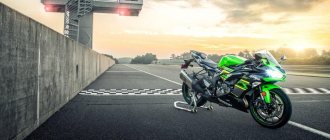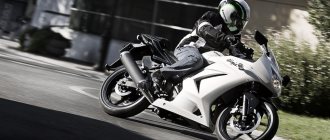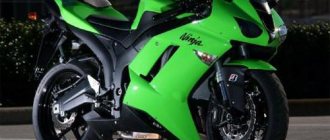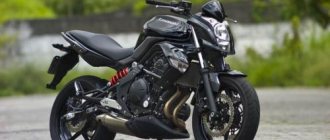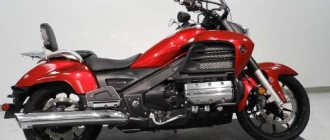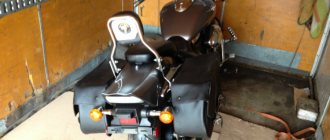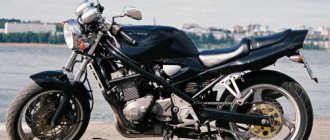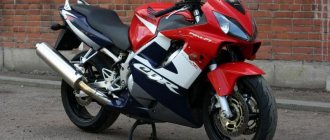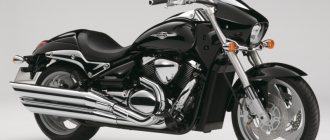Review of the Kawasaki KLE 400 motorcycle
The moto is quite high in the saddle, and as for the ground clearance, it is quite enough to overcome curbs and small littered trees, which promised a fairly wide use of this device, both in the city and on the countryside, without bothering too much with the quality of the coating. Another advantage of a high seating position is good visibility in city traffic. The seating position is comfortable, straight, with my height of 183 I can confidently reach the ground with my feet, the saddle is moderately hard and narrow, which makes it possible to freely pilot the motorcycle “in a standing position.” The brakes are quite sufficient, but reinforced hoses will not be superfluous. In terms of wind protection, I would give a C, because... at speeds above 90 mph, the standard windshield stops coping, but with arms growing out of the right place, this problem can be solved by making a new windshield from plexiglass. The engine is reliable and unpretentious, both in particular and in terms of the quality of gasoline; in the absence of the 95th, the 92nd uses it with a bang (I didn’t notice any difference ), the only thing is that it is quite gluttonous (approximately 8 liters per hundred) and noisy (not in terms of exhaust, but in operation), and the fact that it comes from an ancient sport is rather a peppercorn, which some will like, but others will not. Personally, I’m used to its non-enduric enthusiasm (it helps a lot in the city) and the 6-speed gearbox. In the city and on hard ground, at a calm pace of movement, I simply switch gears through one, and when passing through mud obstacles, the first gear is almost a lower gear (at least with my weight of 85 kilos), this is me in defense of statements about the missing bottoms. I didn’t experience the lack of lower levels. I’ll also say this, this motorcycle is not intended for sports enduro, the dry weight of 170 kg (even with toothy tires) will give you the opportunity to sweat properly if the bike is sat on its belly in some kind of liquid, so my advice is frankly not climb in. Regarding the suspension: it’s better to immediately set the rear shock to the hardest position, as for the front fork, I pump 2.2-2.5 points into it, it’s quite rigid and controllable. When using a motorcycle in forest rides, it is better to increase the front fender (make it from a piece of car locker a la mudguard) by 8 centimes, this will avoid rapid clogging of the radiator. The plastic is scratchy and likes to rattle at low speeds (this can be cured, but I don’t bother, I’m used to it) ), it is better to install protective arches that will cover it. The instrument panel is easy to read both day and night, the buttons on the remote control are in their place (you don’t have to reach for them), the headlights are at a confident 4, if you wish, you can install additional lights, but it won’t take long to tear them off in the forest. On the highway, the cruising 110-120kemeche is quite comfortable for both the bike and the rider; when overtaking, the engine is dull, you have to click down, but it’s four hundred.
In conclusion, I will say that the motorcycle is easy to maintain, very forgiving in handling (except for stupidity, of course), and convenient for the city and trips to the country. Not too powerful, but quite enough to carry a passenger and luggage. Again, I repeat, this is not a Dakar projectile and it will not be suitable for fishing for tens of thousands of kilometers, at least with the second number (you should not want from it what it is not intended for). He is a faithful friend and comrade, like good old JAVA, which is always remembered with warmth. Plus, it offers great opportunities for little money.
I’ll start with the bad, the consumption is very different; in the forests I got about 8 liters per hundred (20 km of hard wood without slurry and 80 asphalt) in the city the consumption was about 5.5-6 liters. The engine spins great (after all, it contains the ancestor of a sportbike worth it) the biggest disadvantage is the complete lack of traction at the bottom (that is, the gas is minimal when driving through sand, mud, horseradish will be trampled, you have to fire the clutch).
The driver's seating position was just right; the car had a low windshield, but it still worked at a speed of 120; it was noticeable if you bent over it a little. IT IS VERY PROBLEM LOOKING FOR REAR TIRES 17 RADIUS (as in Africa, broadcast, pimp) tires are sold out so quickly. The terrible muffler pipes are ordinary metal that rusts; nothing can be done with them; the paint burns (only probably chrome plating, but this is difficult and even unrealistic for an ordinary person). I was very pleased with the instrument panel, I drove mainly only by the tachometer, fortunately it was there))))))). The brakes are awesome, better than on the enduro chekushki but worse than on the SIBI 400 sf (I drove both). It’s easy and good to drive with two people, only the rpm is 1000 more so that acceleration and speed are good (compared to when driving alone). The plastic is very cracky and brittle - I advise you to take care of it. A very incorrect air filter - no matter how Japanese designed it, dust will in any case be sucked in no matter how much or tumbled, poor design of the filter box. I don’t know why there are air vents from the headlight fairing to the frame (there are two large intestines), dirt, water and other crap flies there, and it all ends up exactly in the recesses for the spark plugs. Heavy iron pendulum, rear suspension is adjustable by the weight of the driver (I wanted to install it with adjustment... I wanted it... I wanted it... but I sold it). The fork is very flimsy, very thin for such a wheel (you need a 3rd yoke for rigidity). The motorcycle is very heavy for sand, but on the road it’s not noticeable, you can ride over curbs, but you don’t want to feel the weight of 160 kg falling off the curb. During the entire time of my ownership, I drove about 3 thousand (I still regret very, very little), in principle it never let me down, if not for its already ruined condition, I sold it because of 2 things, heavy and spent a lot.
Kawasaki KLE500: 498 cm3, 48 hp, 178 kg, € 6549There are models that are timeless. They can remain unchanged in a company’s production program for more than a decade; several generations of motorcyclists grow up on them. A universal set of qualities and a reasonable price make these machines popular. In addition, such motorcycles are often taken as the basis for the development of newfangled contemporaries, and even congenital shortcomings do not spoil them. The “parquet” enduro KLE500 is just one of those. At the end of the 80s of the last century, the Japanese concern Kawasaki made another attempt to conquer the European market. It is not surprising that the attack was planned on one of its largest segments - budget urban enduro. The then fascination of Europeans with SUVs determined both the characteristics of the model and its appearance. The KLE500 had to look as close as possible to the image of a touring enduro – everything is clear, practical and comfortable. Well, since Europe had excellent road infrastructure, they decided not to focus too much on the off-road qualities of the car. The KLE500 was initially positioned as an asphalt motorcycle.
The desire to make the model budget-friendly and unpretentious in operation determined the choice of the power unit – a two-cylinder “in-line”, which was successfully tested in the GPZ500S chassis. The engine was deformed and enclosed in a steel tubular frame. The chassis has long-travel suspensions, large spoked wheels and disc brakes. The wide half-fairing was designed to protect the driver from weather adversities, as well as direct air flow to the radiator of the cooling system. The first modification, which debuted in the fall of 1990, featured a very modest windshield above the headlight and a flat saddle.
The model was greeted with a bang. The KLE500 coped equally well with dense city traffic and the endless “ribbon” of highways. Considerable overall dimensions, as well as rally gadgets such as engine protection and hand guards on the steering wheel, made the car look solid and beautiful. As for some technical and ergonometric nuances (for example, an uncomfortable saddle, poor lighting technology, low ground clearance and flimsy engine crankcase protection), the developers were in no hurry to correct them. The first modernization took place in 1996, and even then it only concerned the enlargement of the windshield and the saddle (it became stepped). Many hoped that the KLE500 would become the first-born of a whole series of touring motorcycles from Kawasaki, but the company did not see any prospects in the development of this niche. Even in 2000–2004, when many competitors introduced new generations of machines in this class, Kawasaki remained true to its own beliefs. Only at the end of last year was the restyled KLE500 introduced, which again differed from its predecessor only in a new semi-fairing with a proprietary patented “air curtain” system (the system changes the direction of air flow and removes excess wind pressure from the motorcyclist). The headlight and windshield deflector are made in the aggressive style of the Kawasaki Z1000 model, and the turn indicators are based on the Z750S motorcycle. The saddle cover now has sidewalls made of anti-slip material, and the shape of the top of the saddle is made deeper to improve control over the machine when the motorcyclist sits in the saddle or operates the device while standing on the pegs. Surprisingly, the power system remained carburetor. True, for the sake of Euro-2 standards, two catalysts had to be installed. But even with all this, the latest generation KLE500 is not much different from its ancestor. Why has the company remained faithful to this model for so many years? Do its characteristics meet modern requirements? How justified is the operation of such a “SUV” in Russian realities? Our experts tried to answer these and other questions.
Alexander Astapov, Deputy Editor-in-Chief of Motor Review Height – 182 cm, driving experience – 20 years, drives an Italjet Dragster XX KLE? Under Zdorov? “Laughing”! Vovan, didn’t you want to buy a KX60 for yourself? He perched himself, big thing, on a girl’s motorcycle... Yes, yes, it was Kawa who was the first to find the recipe for an excellent ladies’ motorcycle. Here BMW and the Italian branch of Honda are bending over backwards in search of the optimal motorcycle concept for the fairer sex, but come on, this one has been produced for a hundred years by some shipbuilders and machine tool builders (more precisely, it was produced - the Restyle spoiled the breed a little). If you don't believe it, admire it. Firstly, appearance. Created a decade and a half ago, KLE still looks great. Moreover, contrary to the habit of throwing poop at the design of the end of the last century, here I am forced to admit an exception to the rule. The restyling of two years ago, although it made the appearance more modern, is unlikely to be more stylish. Having also killed the lion's share of the motorcycle's charm. As a matter of fact, any attempts to improve something externally are doomed to failure (even the first mini-restyle, with the installation of a windshield, did not benefit the Kava). If only we put good hand protection and change the corrugations on the fork the color of grandfather’s underpants... And “Kava” is good! “Sleek”, but without being “soapy”, cocky, but not aggressive. Yes, the bias towards Dakar vehicles of the two-cylinder era is obvious. But don't ladies like crossovers like the Lexus RX300? And behind the wheel you understand: the motorcycle was definitely tuned for girls. Thin and relatively long-legged. With their weight and size characteristics, the suspension will work as it should: swallow potholes on the asphalt and even on the dirt roadside, and at the same time the plastic crankcase protection will not rub against the terra firma. Large wheels are again a plus: a pothole that suddenly rushes under the wheel will not cause panic, because it will be painlessly “run over” by a 21-inch tire with a universal pattern. The brakes are not the most powerful - but the motorcycle was not designed for aggressive use. They are enough to slow down and not block the front wheel.
And the motor is nothing! Once obtained from half an engine from the legendary GPZ900 and derated (originally for installation in the chopperoid EN500), it has quite a cheerful character. Without pepper, of course, unlike the 60-horsepower version for the GPZ500, but when compared with the very thoughtful “single-barrel” from the same age as the KLR650, the difference is clearly in favor of the EN. It spins, hums, and the device accelerates to 160 “on the instruments” - well, okay. Or did someone here want a thrill? And who will cook dinner while you, my dear, hang around hospitals? But my wife doesn’t want a motorcycle. (At least, I never even thought about it). But I definitely don’t need KLE. And if I needed a sneeze-puff for broken asphalt, I would rather buy Transalp. Its suspension does not sag under my by no means gigantic weight, and the motor is livelier in the “middle”. Although the design, of course, is by no means “kaelesh”. What can you do, the Japanese succeed in creating a motorcycle exterior once in a dozen attempts...
Vladimir Zdorov, Motor Review expert Height – 193 cm, driving experience – 14 years, rides a Suzuki TL1000R sportbike. This Kawasaki was my first new Japanese motorcycle. It’s as simple as that, I simply came to the store and asked to wrap it. There were several reasons that influenced my choice. Well, I just couldn’t part with my old dream of “riding” to Vladivostok. And the Kava, as I remember very well now, when new, cost $7,800, I emphasize: for a completely new motorcycle. The temptation was great, and the concept of a two-cylinder “parquet” enduro seemed to me then almost ideal for long trips around our vast homeland. Therefore, at today's fitting I simply entered the river of the past, actually refreshing the never-forgotten experience of operating the 1994 season. In which my “Herring” (as I lovingly called my KLE500) in the merciless mode of endless trips and travels, covered more than 42,000 km on its wheels.
However, subsequent practice showed me how wrong I was. During more or less long trips, several unpleasant features of the model surfaced at once. The narrow seat begins to disturb the other part of its “continuation” after just a few hours of travel, forcing you to fidget uncomfortably around it in search of at least a small reduction in the constant torment. And the 15-liter gas tank is also not God knows what volume, suggesting quite frequent stops for refueling. At the same time, you need to understand that the almost 50-horsepower derated engine from the company’s rather funny GPZ500 sportbike, frankly speaking, is not enough for this motorcycle, which constantly forces the in-line two-cylinder engine to be cranked almost to the maximum speed on the tachometer. In retaliation, the motorcycle begins to consume no less than eight liters of gasoline per 100 km. In total, we get a power reserve of just over 150 km. Not a lot, in a word.
There is also such an interesting feature - the suspension on the “Kava” is quite long-travel, and the ground clearance, which is already not outstanding, when landing on the device, decreases to values more likely characteristic of some kind of sportbike than an enduro, even “ parquet." All this, combined with our amazing quality roads, leads to the fact that under certain circumstances or simply when driving with a passenger, it is quite possible to reach the asphalt with engine protection. Although outwardly the “Quack” is a real conqueror of the Dakar - mufflers pulled up right under the seat (by the way, they burn out literally after 5000 km, making a disgusting gurgling sound), a 21-inch front wheel, a developed plastic lining, a speedometer immodestly marked up to 200 km /h... Almost a real combat weapon for overcoming off-road conditions. However, do not delude yourself, all this is just an external environment that has nothing to do with reality. Off-road, our ward is completely helpless - the engine, although derated for better torque (in the GPZ500 version there was 60 hp), cannot please at all with torque at low speeds, forcing itself to be cranked up to at least 5000–6000 rpm , where it finally begins to feel more or less bearable. But in the mud, such a character is simply no good. Expensive and extensive plastic cladding also does not add confidence to those who like to mix dirt, and this is also not helped by the small curb weight. And the already mentioned insignificant ground clearance in combination with a long wheelbase leads to the fact that at any, even the most insignificant bend in the terrain, the motorcycle begins to scrape its belly.
In general, off-road it’s not even a “SUV”, but rather an all-wheel drive station wagon, the owner of which mistakenly drove where he shouldn’t, naively believing that he had a passable car. Unfortunately, our hero doesn’t really shine on the asphalt either. As soon as the speedometer needle passes the 150 km/h mark, the strength leaves the 500 cc wimp, the subsequent kilometers/h are especially difficult for it... And at 170 km/h the acceleration stops. In other words, even the owner of some late-model VAZ-basin can laugh at you. And the small fairing does not contribute to high speeds. The effectiveness of wind protection is minimal.
Kawasaki turned out to be a strange enduro. It is frankly unsuitable for off-roading, it resembles the princess and the pea, but on the asphalt it looks more like a 75-year-old pensioner who decided to go jogging in the morning, but after the first 100 meters he was breathing heavily, constantly clutching his heart and looking around in search of a bench... And even The fact that the motorcycle was completely new did not save me from visits to the service center - it broke down. Moreover, the most unpleasant thing was precisely that, turning a blind eye to the lack of power and other features of the motorcycle that did not please me very much, I bought it precisely because it was new. I thought this would save me from trips to service technicians... Alas, the current test did not bring any new impressions or nuances that I had not noticed before. Still the same good old “Kava”... But I never went to Vladivostok. But I'm sure it's just a matter of time.
Nikolai Bogomolov, Motorreview expert Height - 183 cm, driving experience - 8 years, drives a Honda CRF450R This fall I happened to be left without a two-wheeled vehicle on public roads. I had to think about a new thing. Suitable not only for city driving, but also for long-distance driving on roads of varying degrees of severity: from dirt roads to highways. Naturally, we had to choose from “parquet” enduros. Most of the not so rich market was already familiar to me, but I never had a chance to ride the Kawasaki KLE500. Meanwhile, it was for this and for the domestic Japanese 400 cc younger brother that more than favorable prices were established on the Russian market. The Kawasaka looks solid. Spoke wheels, which are tempting to put more grippy tires on them, a wide cross-country steering wheel with handle protection. True, it will only protect from the wind. Firstly, in a collision with foreign objects, the frail plastic mugs will fly apart along with the controls. Secondly, the damage from the most insignificant fall will be such that broken levers will seem like a trifle compared to broken, expensive plastic. A useful detail is a platform for a trunk behind the seat. But the “tidy” is not modest in a tourist way: there would be a fuel level indicator, a couple of tripmeters and a clock.
The GPZ500, loudly called a sports tourer, has long sunk into oblivion, but its engine continues to live in a derated version on the KLE. The already not the best of engines did not become any more interesting after such modification. The power decreased, but the outstanding “low-end” did not appear. So the motorcycle is suitable only for those who are not in a hurry: the cruising speed is 150 km/h; with patience, you can reach the 180 mark. The suspension does not work the best even on asphalt. The soft fork begins to peck when braking, so much so that you can get scared if you’re not used to it. However, the suspension copes well with uneven urban terrain. You can drive at full speed onto tram tracks or jump off a high curb without any problems. The “sitting high, looking far” position is ideal for navigating through traffic jams. You can confidently move on moderately broken dirt roads. But in real off-road conditions the real difficulties begin. Low ground clearance and high weight add to the sluggish operation of the fork and shock absorber. With such a gentleman's set, there is no great desire to drive off the asphalt, especially when you remember the cost of falling. The engine, which comes to life only at high speeds, is also not conducive to traveling through ravines and swamps.
With comfort, KLE is also not doing well. The vent turned out to be a decorative element: it does not provide sufficient protection from the oncoming air flow. However, by rummaging through catalogs, you can find “tuning” glasses for every taste. The seat is also not particularly comfortable: on a long trip, the back and parts of the body slightly lower will not feel the best. Why is KLE so popular in Europe? Apparently due to the low price. I couldn't find any other good reason to buy KLE. Well, I’ll look for something else for myself, even if it’s more expensive.
Mikhail Lapshin, deputy editor-in-chief of “Motoreview” Height – 193 cm, driving experience – 13 years, rides a Yamaha TDM900 and Yamaha YBR125 It turns out that time flies. It seems like yesterday I was such an enthusiastic and happy young student with the air of a real biker, discussing with a friend all the advantages of this Japanese motorcycle. I was once the happy owner of a slightly used KLE500, and the then prevalence of the Kawasaki brand in Moscow only convinced me that I had made the right choice. What can I say, at that time it was really cool. Therefore, I still remember my prancing on the KLE500 along the boulevard ring with all the inherent motorcycle jokes such as jumping over sewer manholes and squeezing between car mirrors as my first love. After all, at that time I only had experience driving “Tula”, “Ural” and “Carpathians”...
The “first love” factor is a dangerous factor. It is usually difficult to trample and polish with layers of other preferences. And now, when I have a bunch of motorcycles under my belt, and a whole library of different opinions and stories in my head, I look at this KLE500 with awe. How many years have passed, but it’s still just as beautiful! Yes, I know that the device is not great by modern standards. A sluggish carburetor engine, heavy, with a flimsy chassis, soft suspension (their long-travel disappears as soon as you sit in the saddle), any lack of ground clearance and just a bunch of all sorts of technical failures. This is how the engine crankcase drain nut should be positioned! When “kissing” the curb, it is cut off first! And the mud protection... Stop! But with all this, the motorcycle has some kind of aura, which, combined with the low price, allows you to love this device regardless of time. It is no coincidence that Kawasaki still produces it!
In statics it is perceived as nothing other than KTM. The beak-like design of the light optics, the fairing pressed to the “body”, long fork stays, powerful crankcase protection plus mufflers placed almost under the saddle... No, I definitely like it! And so I sit down in the saddle (only 85 kg!), and this conic suddenly creeps obsequiously towards the ground. I don’t see myself from the outside, but I know that at the moment the crankcase protection is already striving for intimacy with the asphalt, and the suspensions have “eaten” the lion’s share of their external achievements. Yes, it is, but for me, 48 “horses” is quite enough for confident and dynamic movement within the city. In “first” you can even easily accelerate to 70 km/h, and if you twist the throttle particularly hard, then the KLE500 can handle the spark plug.
This means this: the device is quite budget-friendly, and there is no need to demand from it the capabilities of the 650 cc V-Strom (the price tag of which, by the way, is almost one and a half times more - $ 11,050). KLE goes for its money quite confidently. I will say this: compared to the previous version, the “new” KLE500 really feels much more confident in the air flow. Now there is no pressure on the driver’s helmet, and the directional stability of this leviathan has clearly improved. As for claims like “doesn’t go more than 180 km/h” or “badly corners with the knee,” this is one of the curiosities of the minds of users who understand the concept of “universal motorcycle” as at least an SUV-sportbike-scooter rolled into one. Don't forget: the KLE500 was created for asphalt, for well-maintained highways, for the benefits of civilization, finally.
For me, the operation of the gearbox, braking dynamics, wind protection in general (although, of course, protection from dirt of some components, especially in Russian realities, should be improved and improved) and driving characteristics look quite decent. Even with a certain amount of tourist load, it quite confidently copes with the “unevenness” of our asphalt. Although the small volume of the gas tank can only be considered a minus for our country. In Europe it is not difficult to refuel every 200 km. Of course, the engine turned out to be not very good in terms of maintenance (the timing chain stretches after 30,000 km), and the carburetors seem anachronistic, but these quibbles are only due to the fact that we are all already sufficiently spoiled by the high technologies of the Japanese and consider them The norm is radical restyling every two years. Perhaps the price and external factor (the latest restyling came in handy) once again made it in demand in many markets, including ours. None of the competitors can offer anything like this, and the fact that this is not exactly a “dark horse” contributes to the choice. An old horse won't ruin the furrow. Let me put it simply: there is still a lot to love about him. And those who constantly doubt something can fork out for much more expensive and modern motorcycles.
Alexander Dmitriev, editor-in-chief of "Motoreview" Height - 183 cm, driving experience - 17 years, rides a BMW R1200 GS KLE500 - one of the first Japanese motorcycles that I became closely acquainted with - in 1996. It was a first generation device without glass and with a flat seat. And everyone liked it - especially the engine. Anyone who has ridden even light off-road conditions on a motorcycle with a two-cylinder engine will understand what I mean. This rower works like an electric motor - smoothly and pulls from the very bottom without any jerks inherent in “single-barrel” guns. The tachometer has an unrealistic “length” for an enduro (red zone from 11,000 rpm) – at idle the motorcycle is able to creep at a minimum speed inaccessible to single-cylinder competitors. But the ground clearance is clearly low...
When trying a copy released in 2005, I did not notice anything that would worsen the excellent characteristics of the motorcycle: at the same time, the saddle became stepped - the passenger no longer constantly slides forward. But the glass, despite the fact that it is visually high, is clearly not enough - it begs for some tuning. The smooth performance is pleasing at any time, and the dynamic capabilities are quite satisfactory - the motorcycle maintains cruising speeds of 140 km/h without any problems, leaving even the moderately rickety Africa Twin behind.
On the weekend I went out of town - and of course, I drove off the asphalt. What can I say, the ground clearance is too small, but not so low as to be too upset about it: the motorcycle could handle a dry, flat path without any problems, but in principle it would not be possible to ride along ruts with such a mass. It is also good on sandy roads. I remembered the run around Elbrus (“Motoreview”, 10/2005). While everyone was on a BMW GS, one of the participants was driving a KLE. I wouldn't say it bothered him too much, and the sump (or sump guard, whatever you prefer) didn't take any serious hits. Of course, if you approach the motorcycle with extreme fanaticism, leaving the highway, while trying to “put” the speedometer on the motocross track, then the KLE is clearly not suitable, it’s better to save up for the KTM. And for a calm, measured ride, this motorcycle is what you need. At least for me it is much preferable to, say, the KLR650 or Africa Twin.
